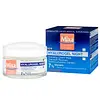What's inside
What's inside
 Key Ingredients
Key Ingredients

 Benefits
Benefits

 Concerns
Concerns

 Ingredients Side-by-side
Ingredients Side-by-side

Water
Skin ConditioningGlycerin
HumectantSqualane
EmollientDimethicone
EmollientPanthenol
Skin ConditioningZea Mays Starch
AbsorbentNiacinamide
SmoothingAmmonium Polyacryloyldimethyl Taurate
Emulsion StabilisingMyristyl Myristate
EmollientBixa Orellana Seed Extract
MaskingStearic Acid
CleansingPotassium Cetyl Phosphate
EmulsifyingGlyceryl Stearate Se
EmulsifyingSodium Hydroxide
BufferingMyristic Acid
Cleansing2-Oleamido-1,3-Octadecanediol
Skin ConditioningPalmitic Acid
EmollientHydroxyacetophenone
AntioxidantCapryloyl Glycine
CleansingCaprylyl Glycol
EmollientVitreoscilla Ferment
Skin ConditioningCitric Acid
BufferingMaltodextrin
AbsorbentXanthan Gum
EmulsifyingParfum
MaskingWater, Glycerin, Squalane, Dimethicone, Panthenol, Zea Mays Starch, Niacinamide, Ammonium Polyacryloyldimethyl Taurate, Myristyl Myristate, Bixa Orellana Seed Extract, Stearic Acid, Potassium Cetyl Phosphate, Glyceryl Stearate Se, Sodium Hydroxide, Myristic Acid, 2-Oleamido-1,3-Octadecanediol, Palmitic Acid, Hydroxyacetophenone, Capryloyl Glycine, Caprylyl Glycol, Vitreoscilla Ferment, Citric Acid, Maltodextrin, Xanthan Gum, Parfum
Water
Skin ConditioningGlycerin
HumectantDicaprylyl Ether
EmollientPentylene Glycol
Skin ConditioningPropanediol
SolventCetyl Esters
EmollientCoco-Caprylate/Caprate
EmollientPolyglyceryl-6 Distearate
EmulsifyingJojoba Esters
EmollientBehenyl Alcohol
EmollientAcacia Decurrens Flower Cera
EmollientAcrylamide/Sodium Acryloyldimethyltaurate Copolymer
Emulsion StabilisingCamelina Sativa Seed Oil
Skin ConditioningCapryloyl Salicylic Acid
ExfoliatingCetyl Alcohol
EmollientGlycine Soja Oil
EmollientHelianthus Annuus Seed Cera
EmollientHelianthus Annuus Seed Oil
EmollientHydroxypropyl Starch Phosphate
Isohexadecane
EmollientPhenoxyethanol
PreservativePolyglycerin-3
HumectantPolyglyceryl-3 Beeswax
EmulsifyingPolysorbate 80
EmulsifyingSodium Hyaluronate
HumectantSodium Stearoyl Glutamate
CleansingSorbitan Oleate
EmulsifyingTocopherol
AntioxidantTrisodium Ethylenediamine Disuccinate
Parfum
MaskingWater, Glycerin, Dicaprylyl Ether, Pentylene Glycol, Propanediol, Cetyl Esters, Coco-Caprylate/Caprate, Polyglyceryl-6 Distearate, Jojoba Esters, Behenyl Alcohol, Acacia Decurrens Flower Cera, Acrylamide/Sodium Acryloyldimethyltaurate Copolymer, Camelina Sativa Seed Oil, Capryloyl Salicylic Acid, Cetyl Alcohol, Glycine Soja Oil, Helianthus Annuus Seed Cera, Helianthus Annuus Seed Oil, Hydroxypropyl Starch Phosphate, Isohexadecane, Phenoxyethanol, Polyglycerin-3, Polyglyceryl-3 Beeswax, Polysorbate 80, Sodium Hyaluronate, Sodium Stearoyl Glutamate, Sorbitan Oleate, Tocopherol, Trisodium Ethylenediamine Disuccinate, Parfum
 Reviews
Reviews

Ingredients Explained
These ingredients are found in both products.
Ingredients higher up in an ingredient list are typically present in a larger amount.
Glycerin is already naturally found in your skin. It helps moisturize and protect your skin.
A study from 2016 found glycerin to be more effective as a humectant than AHAs and hyaluronic acid.
As a humectant, it helps the skin stay hydrated by pulling moisture to your skin. The low molecular weight of glycerin allows it to pull moisture into the deeper layers of your skin.
Hydrated skin improves your skin barrier; Your skin barrier helps protect against irritants and bacteria.
Glycerin has also been found to have antimicrobial and antiviral properties. Due to these properties, glycerin is often used in wound and burn treatments.
In cosmetics, glycerin is usually derived from plants such as soybean or palm. However, it can also be sourced from animals, such as tallow or animal fat.
This ingredient is organic, colorless, odorless, and non-toxic.
Glycerin is the name for this ingredient in American English. British English uses Glycerol/Glycerine.
Learn more about GlycerinParfum is a catch-all term for an ingredient or more that is used to give a scent to products.
Also called "fragrance", this ingredient can be a blend of hundreds of chemicals or plant oils. This means every product with "fragrance" or "parfum" in the ingredients list is a different mixture.
For instance, Habanolide is a proprietary trade name for a specific aroma chemical. When used as a fragrance ingredient in cosmetics, most aroma chemicals fall under the broad labeling category of “FRAGRANCE” or “PARFUM” according to EU and US regulations.
The term 'parfum' or 'fragrance' is not regulated in many countries. In many cases, it is up to the brand to define this term.
For instance, many brands choose to label themselves as "fragrance-free" because they are not using synthetic fragrances. However, their products may still contain ingredients such as essential oils that are considered a fragrance by INCI standards.
One example is Calendula flower extract. Calendula is an essential oil that still imparts a scent or 'fragrance'.
Depending on the blend, the ingredients in the mixture can cause allergies and sensitivities on the skin. Some ingredients that are known EU allergens include linalool and citronellol.
Parfum can also be used to mask or cover an unpleasant scent.
The bottom line is: not all fragrances/parfum/ingredients are created equally. If you are worried about fragrances, we recommend taking a closer look at an ingredient. And of course, we always recommend speaking with a professional.
Learn more about ParfumWater. It's the most common cosmetic ingredient of all. You'll usually see it at the top of ingredient lists, meaning that it makes up the largest part of the product.
So why is it so popular? Water most often acts as a solvent - this means that it helps dissolve other ingredients into the formulation.
You'll also recognize water as that liquid we all need to stay alive. If you see this, drink a glass of water. Stay hydrated!
Learn more about Water